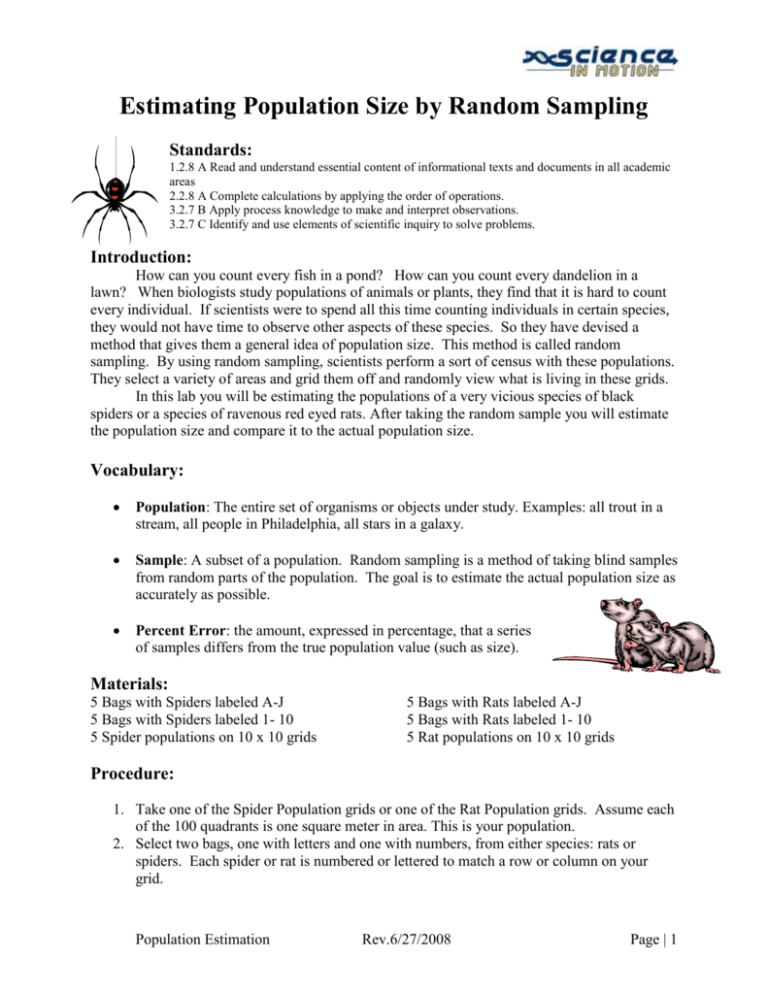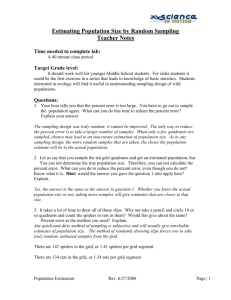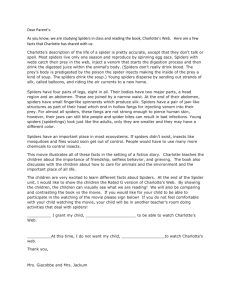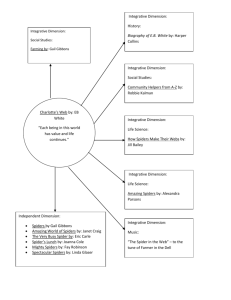Population Estimation by Random Sampling
advertisement

Estimating Population Size by Random Sampling Standards: 1.2.8 A Read and understand essential content of informational texts and documents in all academic areas 2.2.8 A Complete calculations by applying the order of operations. 3.2.7 B Apply process knowledge to make and interpret observations. 3.2.7 C Identify and use elements of scientific inquiry to solve problems. Introduction: How can you count every fish in a pond? How can you count every dandelion in a lawn? When biologists study populations of animals or plants, they find that it is hard to count every individual. If scientists were to spend all this time counting individuals in certain species, they would not have time to observe other aspects of these species. So they have devised a method that gives them a general idea of population size. This method is called random sampling. By using random sampling, scientists perform a sort of census with these populations. They select a variety of areas and grid them off and randomly view what is living in these grids. In this lab you will be estimating the populations of a very vicious species of black spiders or a species of ravenous red eyed rats. After taking the random sample you will estimate the population size and compare it to the actual population size. Vocabulary: Population: The entire set of organisms or objects under study. Examples: all trout in a stream, all people in Philadelphia, all stars in a galaxy. Sample: A subset of a population. Random sampling is a method of taking blind samples from random parts of the population. The goal is to estimate the actual population size as accurately as possible. Percent Error: the amount, expressed in percentage, that a series of samples differs from the true population value (such as size). Materials: 5 Bags with Spiders labeled A-J 5 Bags with Spiders labeled 1- 10 5 Spider populations on 10 x 10 grids 5 Bags with Rats labeled A-J 5 Bags with Rats labeled 1- 10 5 Rat populations on 10 x 10 grids Procedure: 1. Take one of the Spider Population grids or one of the Rat Population grids. Assume each of the 100 quadrants is one square meter in area. This is your population. 2. Select two bags, one with letters and one with numbers, from either species: rats or spiders. Each spider or rat is numbered or lettered to match a row or column on your grid. Population Estimation Rev.6/27/2008 Page | 1 Juniata College 3. Randomly remove one rat or spider from each bag. Record the number-letter combination you have in your data table. Then, find the quadrant that matches the combination and count the number of spiders or rats in that quadrant. 4. Return the rats and spiders to their proper bags and shake up the vicious and ravenous critters. 5. Repeat steps 3 and 4 nine more times until you have counted the number of spiders or rats in ten randomly chosen quadrants. Data Table: LETTER NUMBER NUMBER OF SPIDERS OR RATS IN QUADRANT Calculations: 1. Add up the total number of spiders or rats in the ten quadrants you sampled. Total number of spiders or rats in the 10 quadrants = ___________ 2. Divide the total number of organisms in the 10 quadrants by 10 to obtain the average number of organisms per square meter (one quadrant) Average number of spiders or rats per square meter (m2) ____________ 3. Multiply the average number of spiders or rats per m2 by 100 (the total number of quadrants). This is your population estimate. Population estimate = ____________ 4. Count all the spiders or rats in the entire 100 square meter grid. Note: in a real field experiment you could not count the whole population. Your only measure of population size would be the population estimate. Actual population count = _____________ Population Estimation Rev.6/27/2008 Page | 2 Juniata College 5. Determine the percentage error of your population estimate. To do this, take find the difference between the estimated population and the real population. The difference is always considered a positive number. Estimated population minus actual population = Difference = ___________ 6. Finally, divide the Difference by the actual count and multiply by 100. This gives the percent error. It is a measure of how much the population estimate differs from the actual population. Difference/Actual count x 100 = % Error. The percent error = __________% Questions: 1. Your boss tells you that the percent error is too large. You have to go out to sample the population again. What can you do this time to reduce the percent error? Explain your answer. 2. Let us say that you sample the ten grid quadrants and get an estimated population, but you can not determine the true population size. Therefore, you can not calculate the percent error. What can you do to reduce the percent error, even though you do not know what it is? Hint: would the answer you gave for question 1 also apply here? Explain. 3. Why not take a pencil and circle 10 or so quadrants and count the spiders or rats in them? Would this give about the same percent error as the method you used? Explain. References: For a similar lab that works well with this one see: http://www.geocities.com/CapeCanaveral/Hall/1410/lab-Env-01.html Population Estimation Rev.6/27/2008 Page | 3











